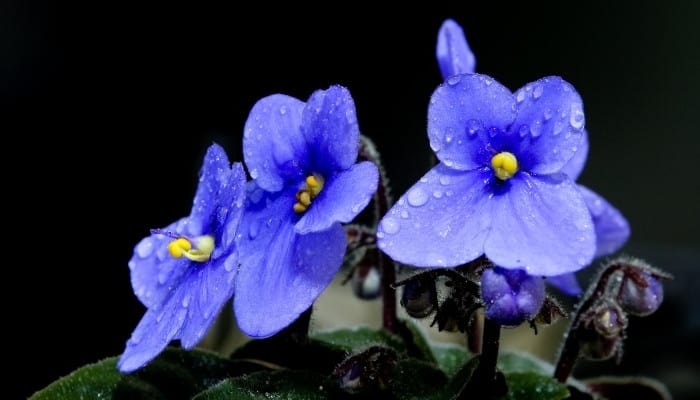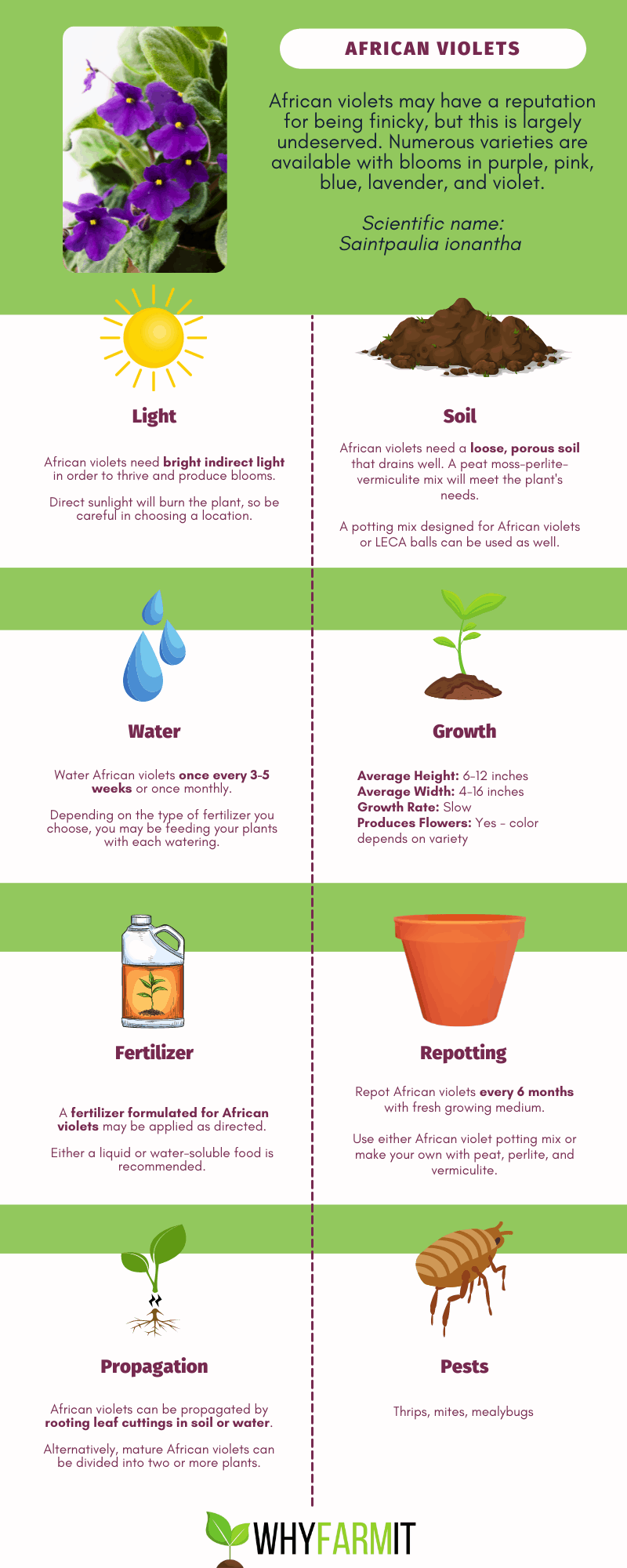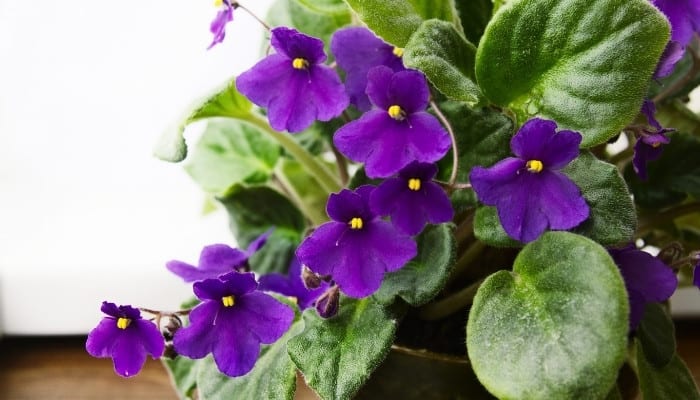African violets are commonly viewed as a unique and challenging plant to maintain. However, despite their delicate appearance, they may not be as challenging to care for as one might think.
Are African violets hard to care for? African violets are quite easy to care for if you understand their basic growing needs. A mix of peat moss, perlite, and vermiculite is ideal. Place the plant in indirect sunlight, maintain temperatures of 65°F to 70°F, and provide at least 50% humidity. Water and fertilize once per month.
African violets are among the easiest flowering houseplants to care for with just a little know-how.
In the following, we’ll provide you with exactly what you need to your pretty plant thriving and blooming.
African Violet Care: Moderation Is Key
Moderation and consistency are the keys to proper African violet care.
Once you understand what type of soil, fertilizer, and light they require as well as their preferred temperature, humidity level, and watering requirements, taking care of African violets is demystified.
Below, we discuss all of the most important aspects of caring for African violets.
The Best Soil for African Violets Is… No Soil!
Traditionally, African violets grow best in well-draining, loose, and porous mixes comprised of no soil.
These mixes are typically made with perlite, vermiculite, and peat. This makes the growing medium light, fluffy, and extremely well draining.
Organic matter can be added as well; in fact the Missouri Botanical Garden recommends this if your home tends to have low humidity.
However, African violets do even better in inert organic growing mediums such as LECA than they do in any type of soil mix.
That’s because with LECA, or other similar growing mediums, the roots of the plants can more easily absorb the water and nutrients they need.
Furthermore, anchored in LECA, African violets may be grown hydroponically or semi-hydroponically as well.
You can learn how easy it is to work with and use LECA in my article here.
African Violet Lighting, Temperature & Humidity
Direct sunlight will burn the African violet’s delicate leaves, so keep the plant only in indirect sunlight.
The most ideal temperature for African violets is 65°F to 70°F, which is pretty precise.
Keeping your flowers in this exact temperature range surely helps encourage a healthy, happy plant and new growth.
That said, as long as the temperature doesn’t fluctuate outside 60°F to 80°F, African violets will be just fine.
Exposure to higher or lower temperature, however, may cause slow or stunted growth cycles.
In nature, African violets grow in 70 to 80% humidity. In your home, they require a humidity level of around 50 to 60%.
That means, if your home has low humidity, you may need to install a pebble tray (it’s easy to make one yourself – here’s how to do it) and mist them to increase their moisture level.
Watering African Violets
African violets are genuinely an easy plant to please once you understand how. As far as watering goes, these little beauties only require a thorough watering once every 3 to 5 weeks.
In most cases, watering your African violets once per month is enough to keep their moisture level where it needs to be.
In the case that your flowers are growing in LECA rather than a potting mix, you may not need to water them more than every other month.
Fertilizing African Violets
Your African violets are simple to fertilize. Pick up a bottle of liquid African Violet food, water-soluble African violet food, or any 14-12-14 houseplant fertilizer, and apply as recommended.
Depending on what product you use, African violets may require watering with fertilizer solution anywhere from once per month to once every two weeks.
Many African violet fertilizers recommend feeding every time you water. Always read the product instructions carefully before applying.
African Violet Repotting
African violets need repotting at least once or twice per year. For the happiest and healthiest African violets, repot your plants every 6 months.
The process is quick and easy: simply uproot the flowers from their pots, and place them in a clean pot with fresh growing medium. The “soil” is light and loose, so they come right out.
Remember that African violet potting soil doesn’t actually contain real soil. Avoid adding actual soil to your potting mix when you repot your African violets.
How To Keep African Violets Blooming

As with most blooming plants, there are numerous tips and tricks to keep African violets blooming. Below, we discuss the most helpful ones.
Keep It Happy
The best way to keep any flower blooming is to keep it happy.
Generally speaking, keeping your African violet happy entails planting it in the right medium, keeping it in the right temperature, and giving it plenty of attention in terms of watering and feeding.
Give It Nutrients
If you’re doing everything you can think of for your African violets and they just aren’t blooming enough for your liking, why not try giving them a healthy dosage of African Violet food?
You may also consider giving them bloom-specific nutrients to try and encourage blooming.
Provide Enough Light
It may seem basic, but failing to receive enough light is one of the main reasons African violets fail.
Simply positioning them near a west- or south-facing window can change the entire game as far as blooms go.
Another idea is to set up grow lights, like these fully adjustable full-spectrum lights, near them when you want them to bloom.
Increase Humidity
Part of making sure your flowers produce great blooms is making sure that they have enough humidity to think they are out in nature.
These guys want more than 50% humidity. Putting them on a humidity tray and misting often are great ways to increase the humidity.
You could also place a humidifier, like this extra-quiet model, nearby.
Give It a Trim
Another common sense way to keep your African violet blooming longer or help it bloom in the first place is trimming it up now and then.
When the top and sides of the plant are covered with new growth, it can be too much for its own good.
That’s when you need to bust out the tiny little scissors and trim your African violets.
Keep It Protected From Pests
One underrated way to help your African violet bloom and stay in bloom longer is by protecting it from pests and bacteria.
The best way to do so is to use organic pest control methods (like spraying with organic neem oil) or highly rated plant-friendly pesticides.
In addition, simply keeping your plant happy and in the right environment helps reduce risk of disease, bacteria, and bugs.
Common African Violet Problems (and Solutions)
- Dusty leaves: Use a small, dry paint brush to gently clean the leaves.
- Long skinny leaves: Move to a location with bright light.
- Spots on leaves: Gently rub with wet cloth, and avoid getting leaves wet in the future.
- Mildew: Increase the amount of airflow.
- Mites: Pick off insects with magnifying glass and tweezers.
Related Questions:
What’s the Best Way To Propagate an African Violet?
Propagating African violets from leaf cuttings is the simplest and most effective way to produce new African violets.
Cut off leaves with a sharp sterile knife or instrument, plant them, and keep them moist. Within a few weeks they will be thriving new plants.
Are Self-Watering Pots Good for African Violets?
Well-established plants work well in self-watering pots; otherwise, the “soil” itself makes the pots unnecessary.
For small plants and clones, self-watering pots are not the greatest option for African violets as they may drain too quickly for the new root systems to grow and thrive.
Final Thoughts About Caring for African Violets
Now that we’ve talked about how to care for African violets, you may already see that they aren’t nearly as hard to care for as you supposed, but that’s only once you know the secrets to success.
When their basic needs are met, they’ll reward you with lovely, tender foliage and gorgeous blooms for years to come.


